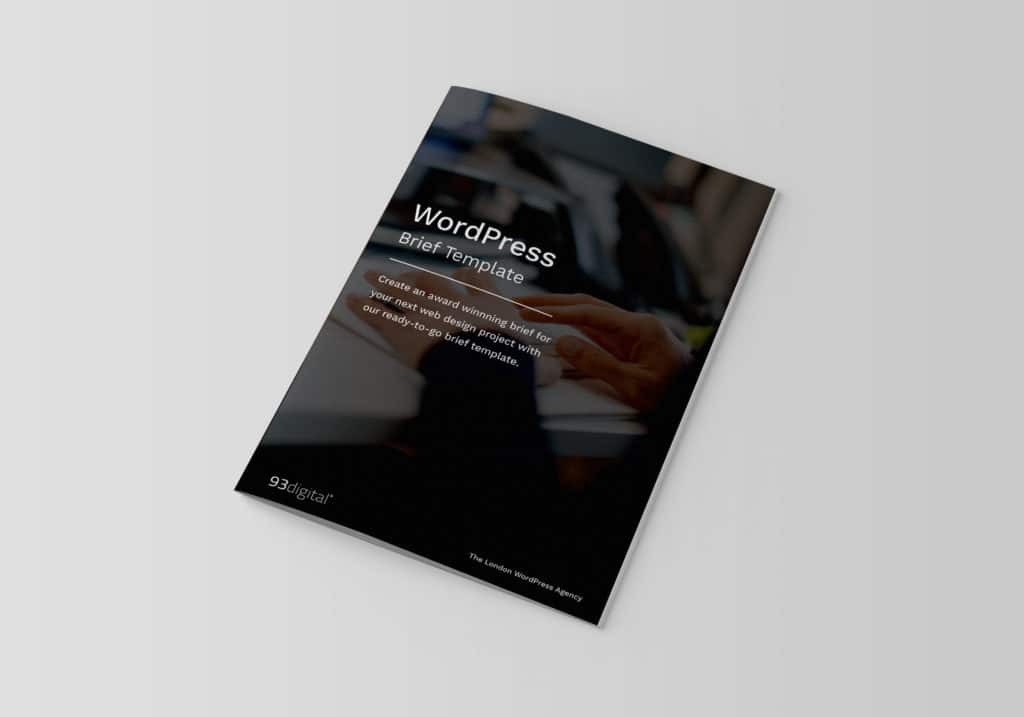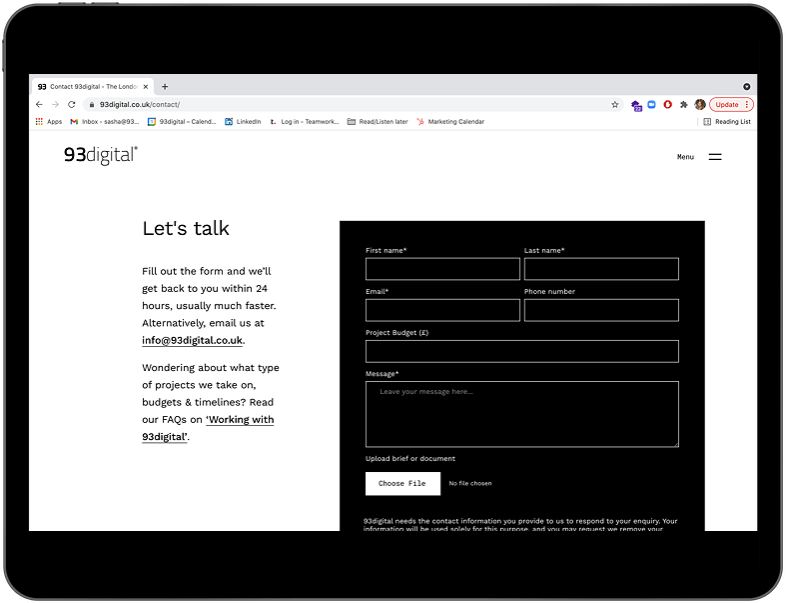Examples of a Website Design Brief (with free brief template)

Once you’ve selected a website design agency, the first thing you’ll want to do is submit a design brief. This document will help you convey all your ideas, as well as those from members of your team.
With endless possibilities for a B2B website, it can be challenging to relay your thoughts succinctly in a brief for a web design agency. Perhaps you’re not quite clear on what to include or what that web design agency might be looking for.
So how exactly do you write a design brief? Let’s have a look at the key factors, with examples of aspects that should be included.
Examples of a website design brief
A website design brief is a document that provides a specification of what is to be designed and built, and lays the foundation for a web design agency to work from. In B2B marketing, your website is a visual representation of your organisation, and a design brief is the beginning of the creative process.
Why do you need one? Well, a website design brief enables a web agency to gather crucial information about your core business functions. It allows strategic design to be woven into the heart of UX. Without one, it will take longer for a web design agency to understand what you want to create, and your B2B website might be less successful upon launch without clear objectives and specifications.
At ClarityDX, we know what a successful website design brief looks like, and why it is so important to communicate in this early stage of the project. Our website design brief template outlines the entire approach, so that you can leave the creative and strategic build of your website to us.
Who is your company?
Your web design agency needs to understand the scope of what you do. The size of your company, your products and services, and the core elements of your organisation, provide a background for your web design project. It’s best to avoid any assumptions, so the more context you give the better.
Target Audience
Your target audience should play a huge part in framing your vision. Knowing who they are and what they’re like will give clear direction for a seamless project. It can be helpful to map out the overall process in a hierarchy map, which forms the narrative your user will interact with when visiting your website.
Think about:
- What drives your ideal client?
- What solution are you offering?
- What experience should your client have when visiting your website?
Your B2B website is not just a shop window; it should be optimised for UX and SEO in every possible way to increase conversion and act as your marketing machine.
What are the objectives?
When building a B2B website, it is essential to know what purpose it should serve in light of your wider business objectives. Whether that be lead generation, brand building, SEO targets or category definition, your B2B website objectives should be outlined in your website brief.
Measurable goals which are focused on data and KPIs will allow you to track success and see if they have been met by the end of the project. KPI driven websites support digital marketing initiatives, such as this website project for enterprise tech company Mitie, who had a surge in MQLs and enquiries after their new site launched.
Our web agency in London delivers website transformations that drive growth with strategic marketing at the heart.
Details of what needs to be built
A clear specification of what should be built removes uncertainty and provides clarity to internal and external parties. Fundamental questions to ask at this stage include:
- What problems are you facing with your current website?
- What needs to be fixed?
- Why do these elements need to be built?
- How will these features optimise the UX for your target audience?
Functionality
You know you need an innovative website that is optimised for user experience (UX), and you need to be able to achieve this in a way that also communicates your core messages.
Your B2B website should be easy to navigate, limit friction and guide the user through their research and discovery. The way a user interacts with your site determines their perception of your brand, so you don’t want high bounce rates as users are frustrated with your site architecture and navigation.
In your design brief, the more detail you can provide as to how your website should function, the better informed your web design agency will be.
- What will happen when a customer fills in details?
- How should responsive design be incorporated and where?
- Media requirements
- Content management system (CMS)
Since B2B products and services can be complex, it pays to think about page layout, which can work to control eyeline and focus, and mitigate the often necessary complexity of copy. Resource hubs are a big tick as they provide a home for SEO content. This helps with higher search engine rankings and nurtures your leads at every stage of the buyer journey.
Competitor research
Have a look at the market space you occupy. Are there any aspects that you like or don’t like when it comes to competitor websites? What would work well for you, and what is an absolute no? Ultimately, this will guide your designers and developers in the design process.
Website content
Your content should portray what you offer in the best possible way. An effective message, that is easy to understand, has your USPs stated concisely. A significant focus for B2B websites is lead generation, so SEO should be built into a website’s core to guide the technical, on page and content requirements.
Points that may seem basic but should be considered include:
- Type of pages
- What appears on each page
- Unique images
As a WordPress specialist agency, we know that a CMS enables you to create and manage content in a visually appealing way. The flexibility of WordPress makes this process so simple and ultimately puts your website in a position for marketing success.
It may be that your marketing team has all your content requirements covered. However, if you do need any help with perhaps a content audit, content strategy or copywriting & production, our SEO and content teams can happily provide support where needed.
Website analytics
We all know Google Analytics is the best out-of-the-box website tracking tool that can help guide your design and development decisions. However, there are plenty more analytics tools that can boost your B2B website, such as Google Tag Manager. On your website design brief, you should mention which tools need to be integrated, or whether you need a custom data reporting dashboard.
Website accessibility
Your target audience should be able to easily access your website as per WCAG. There may be features you need to consider such as keyboard input, alternative text, and language options. There are also different operating systems so it’s important to consider what your website should be compatible with. Think about your user preferences and this will help to frame your answers.
Website host
When it comes to hosting, you should consider which website host meets the needs of your business. For example, WordPress is flexible, secure, accessible, the most widely used and most affordable website host. If you have any specific requirements around your website host, include them in the brief so your web design agency can factor these into the overall project.
We recommend hosting with specialist WordPress hosting companies, our preferred choice being WP Engine. Specialist hosts provide optimised hardware and software, as well as layers of security technology built just for WordPress that will keep your site safe
Website look and feel
A cohesive style should be consistent across your website so that your user recognises your message and brand identity. Not only should your B2B website have a strategic design through UX and SEO, it should make an impact, reflect your brand values and stand out amongst competitors.
Consider how you’d like your website to look and feel. In your website design brief, you could include examples of competitor websites that have struck your interest, or any website for that matter, which reflects aspects of your ideal website. Take note of colours, layouts, user journeys and features that you think would suit your brand.
Relevant stakeholders
It is vital to identify who will be responsible for different aspects of the website project. You should know who will update the brief when the specification changes and who the main point of contact will be.
If at this stage you do not have specific people in mind, define the roles that each person will play once these have been assigned. Designers and developers, project managers, content creators and editors are some of the key roles involved.
Timeline
An agreed timeline ensures everyone is working towards the same goal. Having an idea of an acceptable timeline will help your web design agency know how quickly you’d like to launch your new B2B website. Note: clients often underestimate the time a B2B website project takes, so it might take longer than you think. Read our blog, ‘How long does a B2B website project take?’ to learn more.
Milestones are one way to make sure your B2B website project is on the right track as it moves through each stage of the design and build process. Using our website design brief template will prepare you to think about your unique deadlines. Adopting a phased approach where the project is into split stages also works well. Progress can be measured at intervals, and always allow time for testing at various stages.
Project Budget
Defining a project budget enables your web design agency to manage expectations around what can be delivered. Keep in mind that by trying to negotiate a cheaper deal, you may be compromising certain features or phases on the design and development, like research and discovery that will ensure your B2B website is strategic. This is why it is important to have a detailed discussion with your web agency about your vision, objectives, expectations, and the cost at which you’ve budgeted for the project.
It’s all in the details
In a digital marketplace, your website can be your B2B marketing machine, and a detailed brief is the first step in achieving this. Get started with our design brief template to set up your organisation for digital marketing success.
Once you’ve submitted your brief and chosen a B2B web agency, here’s how marketers can prepare for a website project.
Post updated 18/4/24

Google’s New Cookie Update: What it Means for Marketers

How to add a HubSpot form to your WordPress site
Let's Talk
Do you have a web design and build project coming up that you would like to talk about?